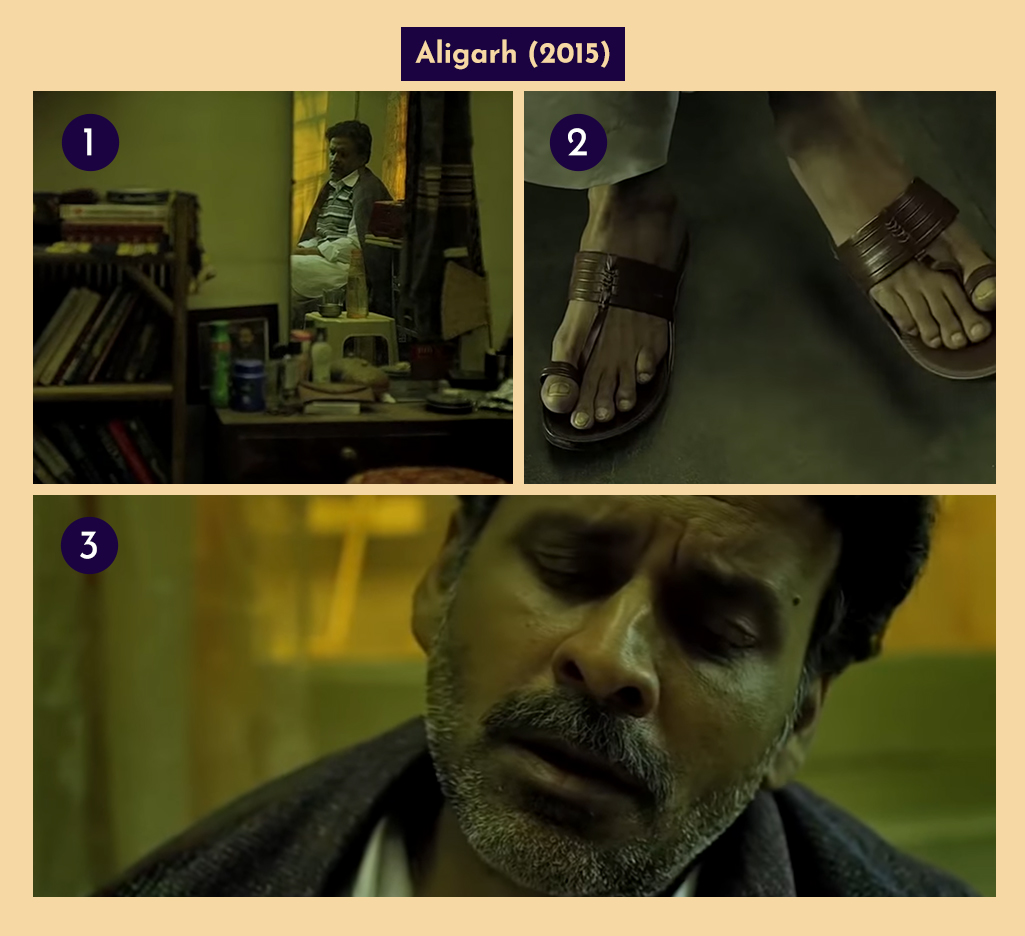New Age Films & Web Series’ That Aced It With Editing
[/vc_column_text][/vc_column][/vc_row][vc_row full_width=”stretch_row_content_no_spaces” gap=”35″][vc_column width=”2/12″ css=”.vc_custom_1561015863493{padding-right: 20px !important;padding-left: 20px !important;}”][/vc_column][vc_column width=”6/12″][vc_column_text css=”.vc_custom_1564147257650{margin-bottom: 100px !important;}”]Mozat had famously said that music is not in the notes, but in the silence between the notes. When talking about film, this can be used as a metaphor for the cuts, the transitions made in between scenes, that speak the language of Cinema in silence. The cuts are where many of the tricks of the magic of cinema can be found- they are designed to go unnoticed by the audience, and yet hold many deep secrets of film. In our new series called “Deep Cut”, we will pull this exact trick out of the magic of cinema and present it to you, by talking about how the cuts affects a scene or the whole film, and how the masters use this magic to make a comment, or set a mood.1. Aligarh (2015)
When the cuts are minimal, they draw our attention just for a fleeting moment more than usual. This has always happened in films in private, intimate moments. And here is a scene in Hansal Mehta’s ‘Aligarh’, one of the most scintillating private moments you’ll come across on film, that humanizes the language of film with empathy, and meaningfulness.
We follow the lonely life of the much wronged Professor Siras, who is attacked by jealous colleagues citing his sexual preference. The core struggle for Siras is one of his identity as a homosexual – hounded by his fraternity. At his very heart, Siras is troubled by how a person’s identity should deprive him of basic human rights. As his identity is ripped apart outside the doors, at home, behind the doors, Siras uses alcohol and Lata Mangeshkar as his pathway to feel like a basic human once again.
This scene shows us a beautiful glimpse of that – Mehta and editor Apurva Asrani achieve the effect with just a few cuts in a moment of respite. The first shot is of Siras’ reflection in the mirror, as the song “Aap Ki Nazron Ne Samjha” sets off on a tape – the reflection is a reminder of his identity, his ‘special case’ as society deems it to be, a ghost that follows him into the private world of his room and shows itself in the mirror. As the song soars, and the alcohol begins to take over, Mehta cuts to a shot of his feet wagging to the musical rhythm, as if the quiet dance were becoming a flight of escape out of Siras’ misery. And then finally, when the song is in full effect, the intoxication of the alcohol and the music take him away from his mental rut, his identity crisis, and Siras shuts his eyes and sings the song – for a moment, he has escaped the reflection in the mirror, and Mehta cuts to this shot (3) recognising how this moment is special. Siras is stealing a moment in his very private world to feel like a basic human once again, and Mehta creates this small world of relief by framing him in an extreme close-up, lost in music and away from the usual social malice, as if in this privacy, he is Alice who has just found the magic Wonderland.
2. Made in Heaven (2019)
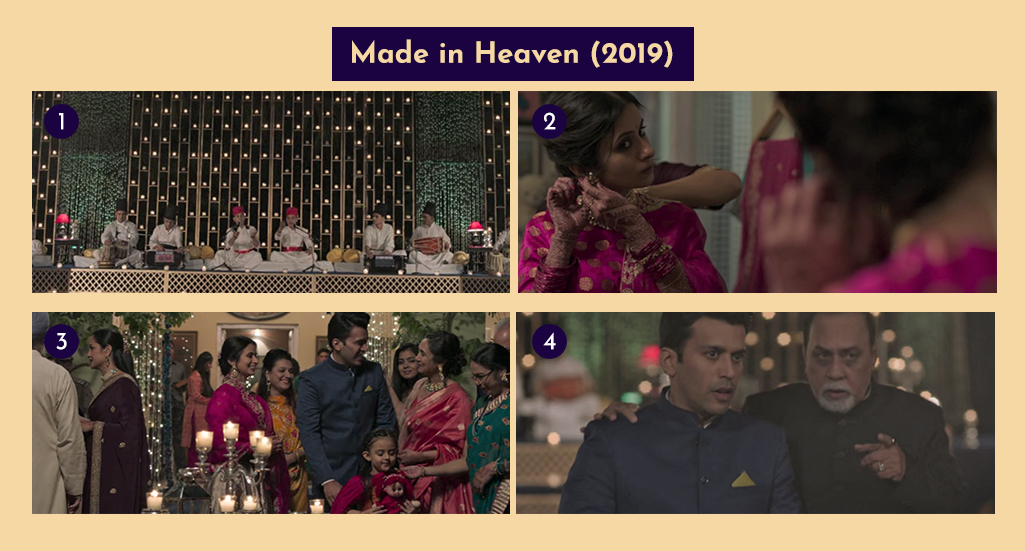
In the finale of Made in Heaven, Nutan Yadav is being forced into marrying Vishal Singh for her father’s political gains. But we know that the wedding planners are conspiring to bring Nutan out of this pit and unite her with her lover. At a wedding party where Nutan is rescued, let’s take a look at how, through cuts and staging, director Alankrita Shrivastava not just foreshadows Nutan’s rescue, but also makes a comment on the hypocrisy of those in power. The party is absorbed in a Qawwali performance that says
“Aye Ri Sakhi More Piya Ghar Aaye
Bhaag Lage Iss Aangan Ko”
(look friend, my lover arrives at home, many blessings be made to this courtyard)
The irony is that a marriage that is a forced compromise at its roots, is celebrated through a song that talks about a lover’s arrival and the blessings it brings. The hypocrisy is that here they are, the masters of submission, staking their claim over even the radical, romantic spirit of qawwali in their fake social celebration. Alankrita cuts from this stage (shot 2) to Nutan dressing herself in front of the mirror (shot 3) and the audio of the song is also cut to a distant undertone – it is Nutan whose lover is about to arrive, the song belongs to her, and the cut of the audio here in Nutan’s shot makes it seem like what is a loud social celebration of theirs, is actually an inherent spirit of hope within her heart.In shot 4, Nutan arrives into the party, and the qawwali sings now, in full blooming audio
“Main Toh Khadi Thi, Aas Lagaaye,
Kaajal Bindiya, Kangana Sajaaye”
As she is regaining confidence, her deep wishes are expressed in the strains of the song that now declares her state loudly, and the spirit of qawwali, that was earlier a shallow celebration, finds its rightful owner now in this shot – someone who yearns and cherishes, just like the song, unlike those around her. Soon she will be rescued and the tyrants will be broken, but the song and the staging was stating that all along.
3. Munna Bhai M.B.B.S (2003)
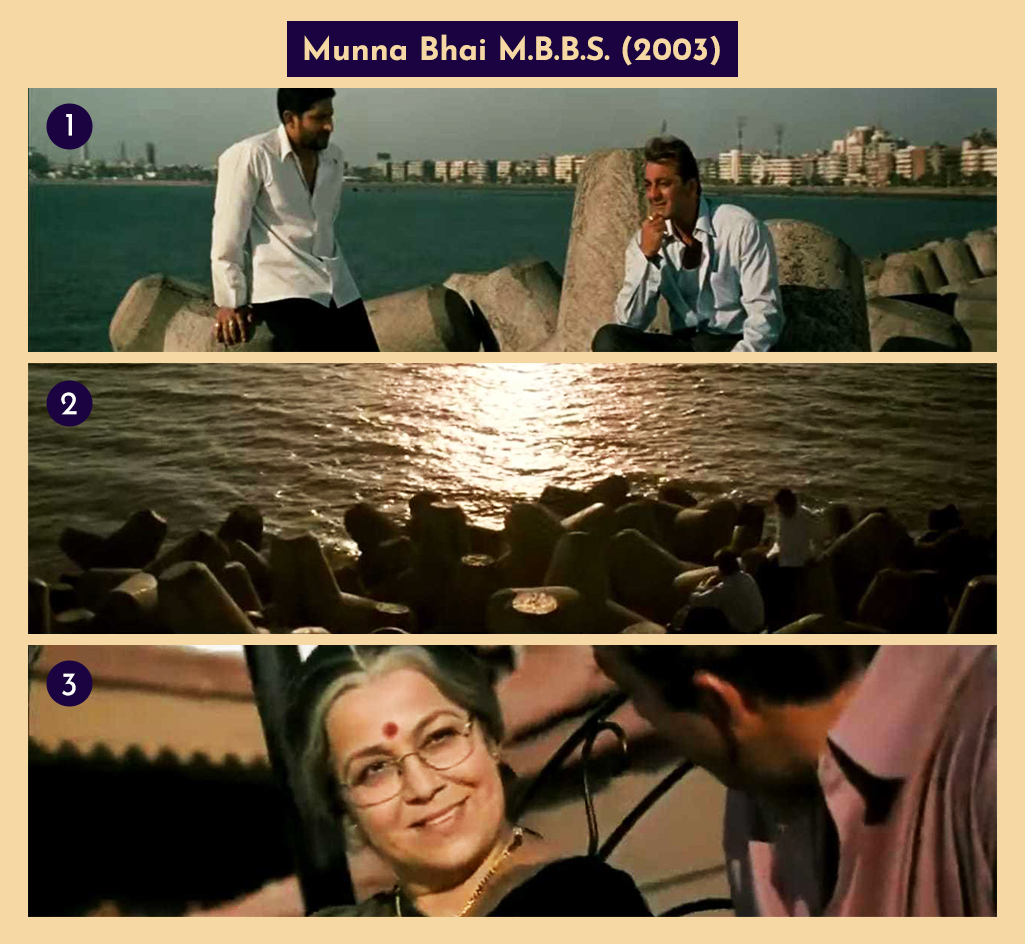
We see the poetic magic that masters create on-screen through a simple cut and the play of light.In the film, Munna switches into ‘doctor mode’ upon his parents’ arrival. Some superb comedy is drawn out of this, although this is also a grave issue – Munna is a liar who’s keeping his proud parents in the dark. In the scene above, the film suddenly nosedives from its comedy into a deep-seated feeling of guilt as Munna and Circuit break away from the chaos to sit and converse by the sea.The most basic nature of being a liar is that you remain hidden from the actual joys of life. Look how Rajkumar Hirani makes this profound point through editing. In shot (1), as Munna tells Circuit to let the fake act go on, he stoops his head in shame, hiding himself from the sublime golden reflection of sunshine on the sea waters. Hirani then cuts to a shot of the sea (2), and with quiet, gentle music, makes us look at the resplendent water. The seawater glows at that hour as if it were a gift of nature, an image of all the bright, simple gifts of life – all that a liar cannot access. By choosing to fake it, and concealing himself behind a lie, Munna is effectively concealing himself away from just these simple joys.
4. Manmarziyaan (2018)
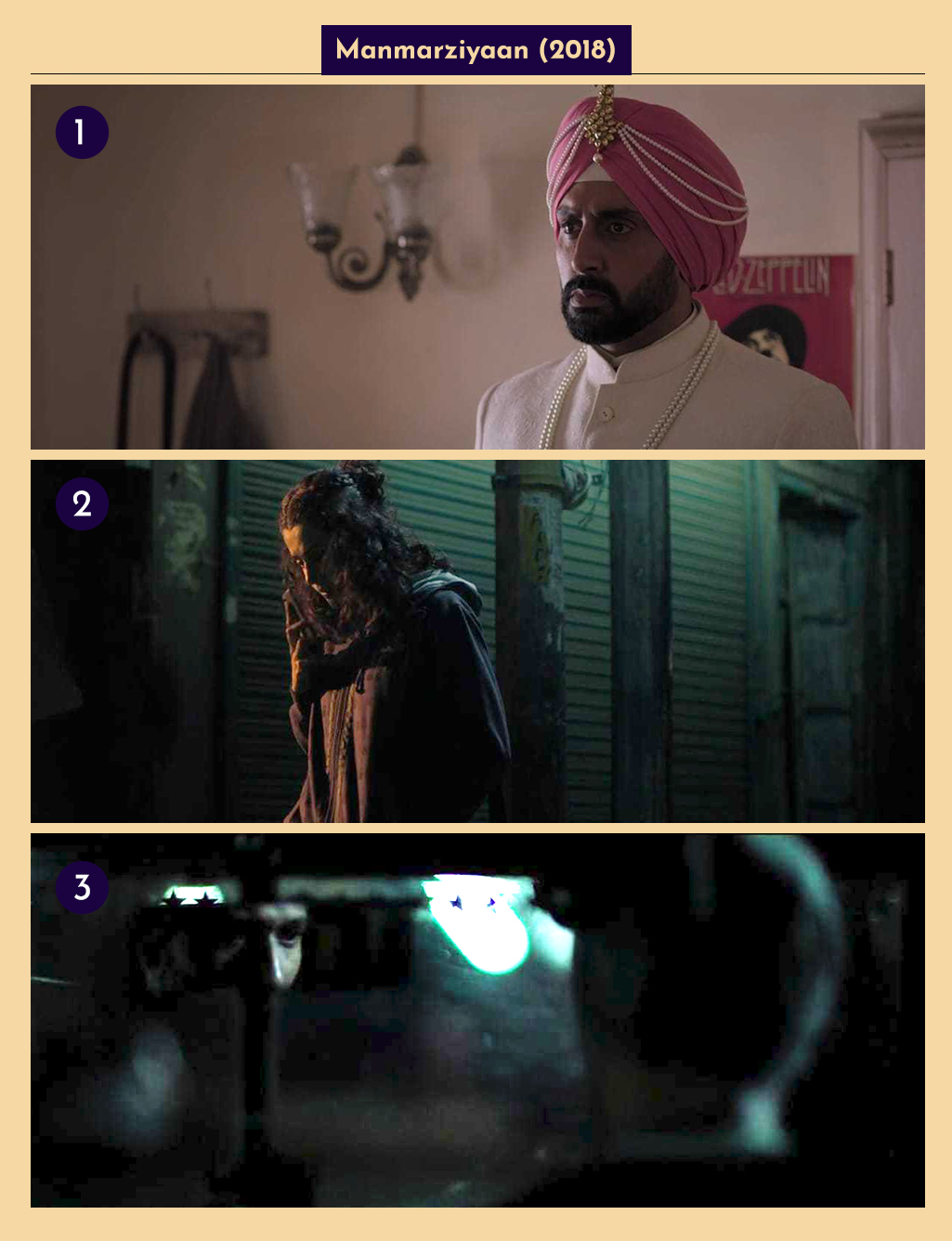
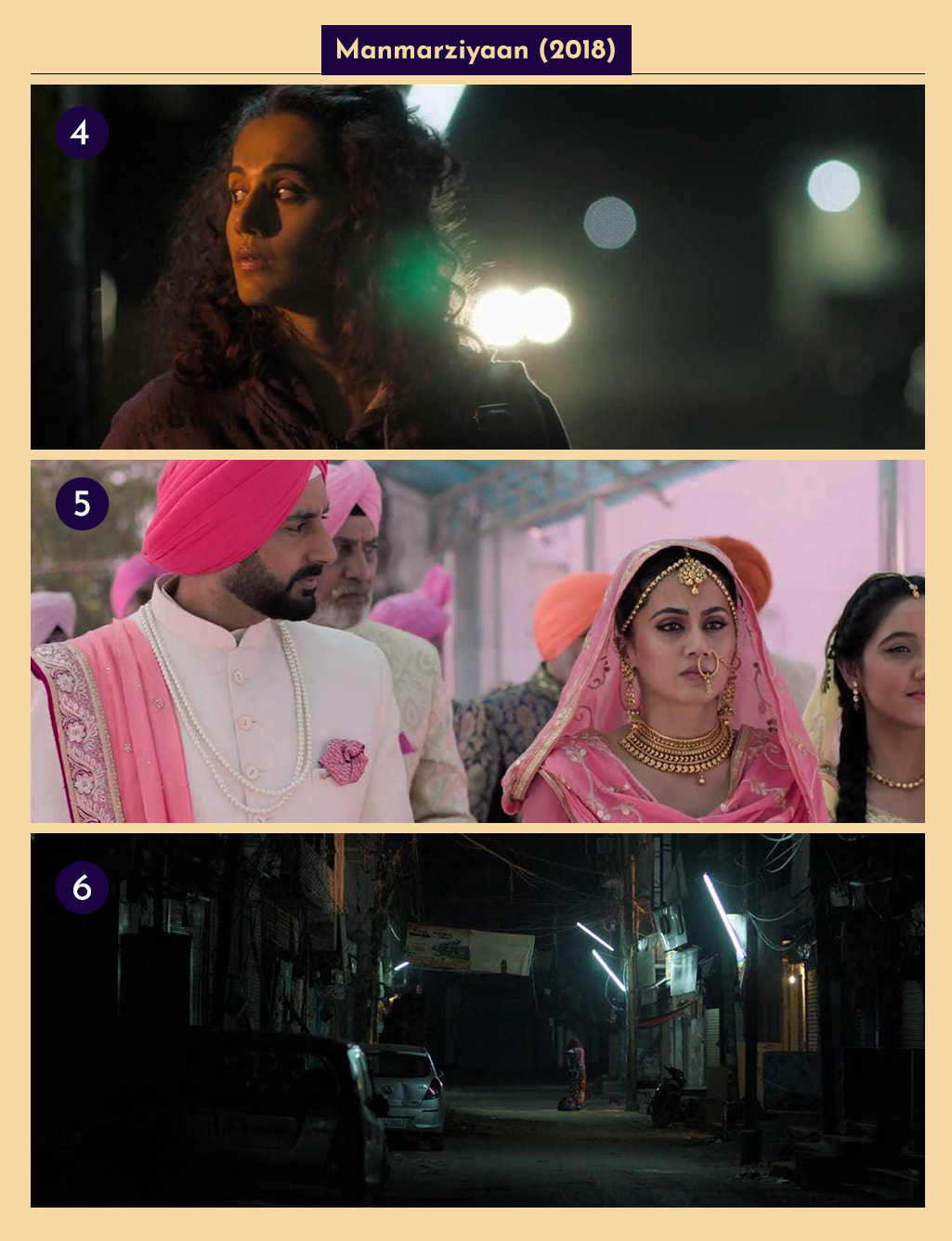
Three people and two relationships are boiled in a personal, social fire in Manmarziyaan.The cooking of this story is very intense and at the interval point, it reaches its peak on the night before Rumi’s marriage to Robbie. Kashyap recognises this as a high point of drama, and watch how him and editor Aarti Bajaj cross cut this scene to make us a part of this intense boiling pot.The core of this scene is that it is at the crossroads for all three of them – does Rumi change her mind? Does Vicky arrive after all? Does Robbie go for his wedding next morning even after he’s told by Rumi that she won’t attend? Thus, Kashyap films them together, with a music throbbing with tension. He even breaks the flow of time abruptly in this sequence by filming Robbie in the daylight (2) and Rumi at night – it makes sense because Robbie, just like us watching Rumi at night (1), doesn’t know her decision in the daytime and thus is part of the unpredictability. The music rises to its peak & stops, Rumi looks in the direction of the light (4), the decision is made, the food cooked.Then comes a beautiful move. Even when the unpredictability is crushed, Kashyap & Bajaj cut between shots of Rumi’s marriage in daylight & shots of the dark alley. They still break the flow of time by cutting between daylight & night. It is a breathtaking moment of visual sense because the contrast built due to cutting the scene this way mirrors the state of Rumi’s mind, and presents to us the spoiled, neither-here-nor-there food that this boiling of relationships has led to. It tells us how in the light of society, Rumi may be tied in marriage (5), but in a dark alley within her, she has still let herself loose, waiting for Vicky (6). Rumi voices this out, when a voiceover by her says “Main tenu phir milaangi!”
We collaborated with Fables of Film to curate the magic that masters create onscreen through simple cuts. Think you can make such keen observations from films like nobody else? Share your writings with us and get featured on India Film Project. Download the IFP app, make your profile, head to the PARTICIPATE section and start sharing your observations![/vc_column_text][/vc_column][vc_column width=”1/12″][/vc_column][vc_column width=”3/12″ css=”.vc_custom_1587562666400{border-left-width: 5px !important;padding-right: 10px !important;padding-left: 10px !important;background-color: #f5f5f5 !important;border-left-color: #1e73be !important;}”][vc_column_text css=”.vc_custom_1587562595155{margin-right: 20px !important;margin-left: 20px !important;border-right-width: 20px !important;border-left-width: 20px !important;}”]
Continue Reading
[/vc_column_text][vc_basic_grid post_type=”post” max_items=”5″ element_width=”12″ gap=”35″ item=”10912″ grid_id=”vc_gid:1587562598004-5b691419-e031-2″ el_class=”grp”][/vc_column][/vc_row][vc_row full_width=”stretch_row_content_no_spaces” gap=”10″ equal_height=”yes” content_placement=”top” css=”.vc_custom_1559458142539{background-color: #1b0341 !important;}”][vc_column width=”1/4″][vc_column_text]50 HOUR FILMMAKING CHALLENGE
Know More
Rules
FAQs
Jury
Awards
Previous Winners[/vc_column_text][/vc_column][vc_column width=”1/4″][vc_column_text]
CHALLENGES
Short Scriptwriting Challenge
Storytelling Challenge
Poster Design Challenge[/vc_column_text][/vc_column][vc_column width=”1/4″][vc_column_text]
FESTIVAL
Schedule
On The Stage
Venue and Travel
BUY PASSES[/vc_column_text][/vc_column][vc_column width=”1/4″][vc_column_text]About IFP
Previous Editions
Branded Content
Labs
Campus Connect
HELPLINE – 9727299070
EMAIL – [email protected][/vc_column_text][/vc_column][/vc_row]

